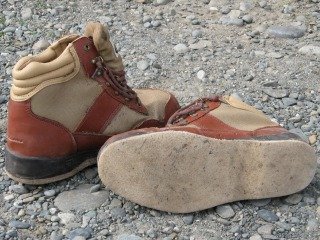 The use of felt-soled boots and waders in Alaska has come to an end.
The use of felt-soled boots and waders in Alaska has come to an end.
The Alaska Department of Fish and Wildlife (ADF&G) is reminding all 2012 hunters and anglers that felt soles are no longer allowed for use in the 49th state’s many waterways. Having long been recognized for their superior grip on slick rocks and slimy streambeds, felt bottoms are now considered obsolete due their unfortunate ability to transfer invasive species.
Viewed by some outdoorsmen as an inconvenience, the move is being applauded by such organizations such as Federation of Fly Fishers and Trout Unlimited, which started the felt-banning movement in 2008 after many blue-ribbon trout streams around the country were found to be ruined by invasive species.
The three culprits responsible for the bans are New Zealand Mudsnails, the Myxobolus cerebralis parasite, and Didymo. Of these, Didymo is the most prevalent and better known as ‘rock snot.’ this organism forms a thick, fibrous mat that can cover the entire bed of any watercourse. Simply put, Didymo kills streams.
Myxobolus cerebralis is a parasite best known for causing ‘whirling disease’ in trout. It infects the trout’s brains and causes them to swim in a corkscrew-like motion that hinders their ability to feed, breath and use cover.
Alaska joins other states in banning felt. Idaho, Maryland, Maine, Missouri, Montana, New Mexico, New York, Vermont and Rhode Island have all adopted similar measures and several other states are poised to follow suit.
For ADF&W information, visit www.adfg.alaska.gov








